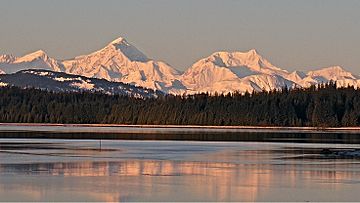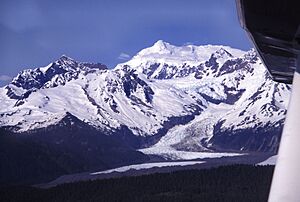Mount Crillon facts for kids
Quick facts for kids Mount Crillon |
|
|---|---|

Mt. Crillon (left) and Mt. Bertha (right) seen from park headquarters
|
|
| Highest point | |
| Elevation | 12,726 ft (3,879 m) |
| Prominence | 7,214 ft (2,199 m) |
| Listing |
|
| Geography | |
| Location | Glacier Bay National Park, Hoonah-Angoon Census Area, Alaska, U.S. |
| Parent range | Fairweather Range, Saint Elias Mountains |
| Topo map | USGS Mount Fairweather C-4 Quadrangle |
| Climbing | |
| First ascent | 1934 by Bradford Washburn, H. Adams Carter |
| Easiest route | West ridge: glacier/snow/ice/rock climb (Alaska Grade 4) |
Mount Crillon is a very tall mountain peak. It is part of the Fairweather Range, which is the southern end of the Saint Elias Mountains. This mountain is located in Glacier Bay National Park in Alaska, U.S..
Mount Crillon sits between the Gulf of Alaska and Glacier Bay. A French explorer named Jean Francois de Galaup de la Perouse gave the peak its name. He named it after his friend, Felix-Francois-Dorothee de Bretton, Comte de Crillon.
Contents
Where is Mount Crillon?
Mount Crillon is about 20 miles (32 km) southeast of Mount Fairweather. It is near the southern part of the Fairweather Range. Only one other very tall peak, Mount La Perouse, is further south.
The mountain is also about 10 miles (16 km) east of Lituya Bay. This bay is a small inlet of the Gulf of Alaska, which is part of the Pacific Ocean.
Glaciers Around the Peak
Several glaciers flow from Mount Crillon. The North and South Crillon Glaciers flow west towards Lituya Bay. The La Perouse Glacier flows south from the peak.
On the north side, the mountain forms the start of the Johns Hopkins Glacier. This glacier flows into Johns Hopkins Inlet, which is part of Glacier Bay. To the east, there is a large icefield. This icefield feeds the Brady Glacier, one of the biggest glaciers in the Saint Elias Mountains.
What Makes Mount Crillon Special?
Mount Crillon is very steep. Its north and west sides drop about 9,000 feet (2,743 meters) in less than 4 miles (6.4 km). Because it is so close to the ocean, the mountain often has very bad weather.
Climbing Mount Crillon
Mount Crillon is not climbed very often. Even though it is not the tallest mountain, it is very hard to climb. This is because it is far away from other places and very isolated.
The first time anyone climbed Mount Crillon was in 1934. The climbers were Bradford Washburn and H. Adams Carter. Bradford Washburn had tried to climb it two times before. They reached the top on July 19, 1934. They climbed using a path called the East Ridge.
Weather Around Mount Crillon
Mount Crillon has a subarctic climate. This means it has cold, snowy winters and mild summers. Temperatures can drop very low, sometimes below -20 °C. With the wind, it can feel even colder, below -30 °C.
The melting snow and ice from the glaciers flow into Glacier Bay and the Gulf of Alaska.



